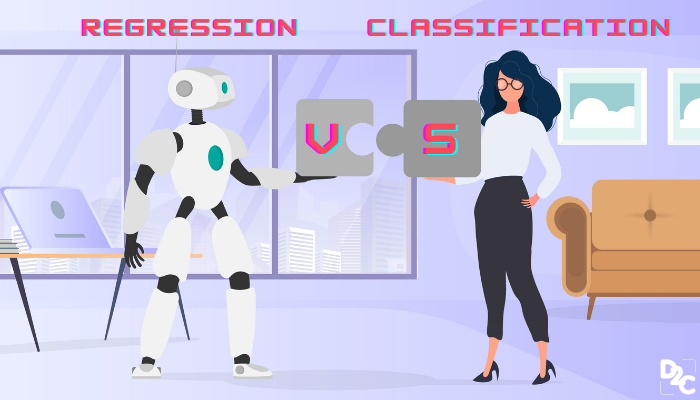Machine Learning 101: Know The Difference Between Classification And Regression!

Machine Learning can take toll on even the most experienced data scientists when it comes to comparing regression vs classification. The differentiation between the two might make it difficult for them to adopt the right technique for tackling prediction issues in the long run.
Classification and Regression are both forms of supervised machine learning techniques in which a model is trained as per the existing model along with a correctly labelled data. However, in order to appropriately execute them and hone machine learning skills, it is necessary to understand the underlying distinctions between regression and classification algorithms.
Regression vs Classification in Machine Learning
To understand the difference between classification and regression, let us first understand each topic in detail.
What is Regression in Machine Learning?
Based on the input data, regression algorithms anticipate a continuous value. The primary objective of regression problems is to estimate a mapping function based on the input and output variables. If your objective variable is a number such as income, scores, height, or weight, or the likelihood of a binary category (such as the chance of rain in specific locations), then the regression model should be used. The different types of regression machine learning include:
1. Simple Linear Regression
If both variables are quantitative, you may use basic linear regression to estimate the connection between one independent variable and another dependent variable using a straight line.
Consider estimating an employee's salary based on his or her age. There appears to be a relationship between employee age and wage (more the age, more is the salary). The linear regression hypothesis is:
Y = a + bX
where, Y symbolizes salary, X is the employee's age, and a and b are the equation's coefficients. So, in order to forecast Y (salary) given X (age), we must first determine the values of a and b (the model's coefficients).
2. Polynomial Regression
In polynomial regression, the original characteristics are transformed into polynomial features of a certain degree and then Linear Regression is applied to them. Consider how the following linear model Y = a+bX is converted into
Y = a + bX + cX^{2}
3. Support Vector Regression
In SVR, we choose a hyperplane with the greatest margin such that the greatest amount of data points fall inside that margin. SVRs are nearly identical to the SVM classification method.
What is Classification in Machine Learning?
Classification is a predictive model that uses input variables to approximate a mapping function in order to find discrete output variables, which can be labels or categories. The classification algorithm's mapping function is in charge of predicting the label or category of the provided input variables. A classification method can use both discrete and real-valued variables, but the instances must be categorised into one of two or more classes.
1. Decision Tree Classification
In this technique, a classification algorithm is built by constructing a decision tree in which each node is a test case for an attribute and each branch branching from the node is a potential value for that attribute.
2. Random Forest Classification
This tree-based method employs a collection of decision trees drawn at random from a subset of the main training set. The random forest classification technique combines the outputs of all the decision trees to determine the final output prediction, which is more accurate than any of the individual trees.
3. K-nearest neighbour
The K-nearest neighbour method is based on the assumption that comparable items exist in close proximity to one another. It predicts the values of fresh data points using feature similarity. The algorithm assists in grouping comparable data points together based on their closeness. The algorithm's main objective is to assess how likely it is for a data point to belong to a certain category.
Classification vs Regression
The primary distinction between regression and classification in machine learning is that, although regression predicts continuous quantities, classification predicts discrete class labels.
|
S.No. |
Classification |
Regression |
|
1. |
Classification Algorithms deal with discrete values |
Regression Algorithms deal with continuous values. |
|
2. |
Classification Algorithms can be bifurcated into Binary classifiers and Multi-class classifiers. |
Regression Algorithms can be bifurcated into Linear and Non-linear types. |
|
3. |
In Classification, the output variable must be a discrete attribute. |
In Regression, the output variable must be a real and constant value. |
|
4. |
Classification computes the output by means of measurement of accuracy. |
Regression computes the output values by means of the root mean squared error. |
|
5. |
In classification, we try to find a distinction between the two classes ie. a decision boundary. |
In regression, we try to find the best fit line which helps in predicting the output accurately. |
|
6. |
We use classification algorithms in use cases such as spam detection, handwriting detection, disease detection, etc. |
We use regression to predict numerical output values such as in the case of house price detection, age prediction, stock price prediction, etc. |
Overlaps in Classification and Regression
There are significant similarities between the two types of machine learning algorithms as well.
- A regression method is capable of predicting a discrete value in the form of an integer number.
- A classification algorithm can predict a continuous value if it is in the form of a class label probability.
Understanding the differences between regression and classification algorithms will assist you in applying machine learning ideas more accurately. Some algorithms may need both classification and regression techniques, which is why a thorough understanding of both is essential.
Read the below articles to brush up on your tech basics:
- What is the difference between Class and Object? Explained
- What are the characteristics of a modern DBMS?
- Difference between CHAR and VARCHAR: String Data Types in SQL Server
- Black Box Testing vs White Box Testing: Know the Key Differences
- Basics of web development: Advantages and disadvantages of HTML
Login to continue reading
And access exclusive content, personalized recommendations, and career-boosting opportunities.
















Comments
Add comment